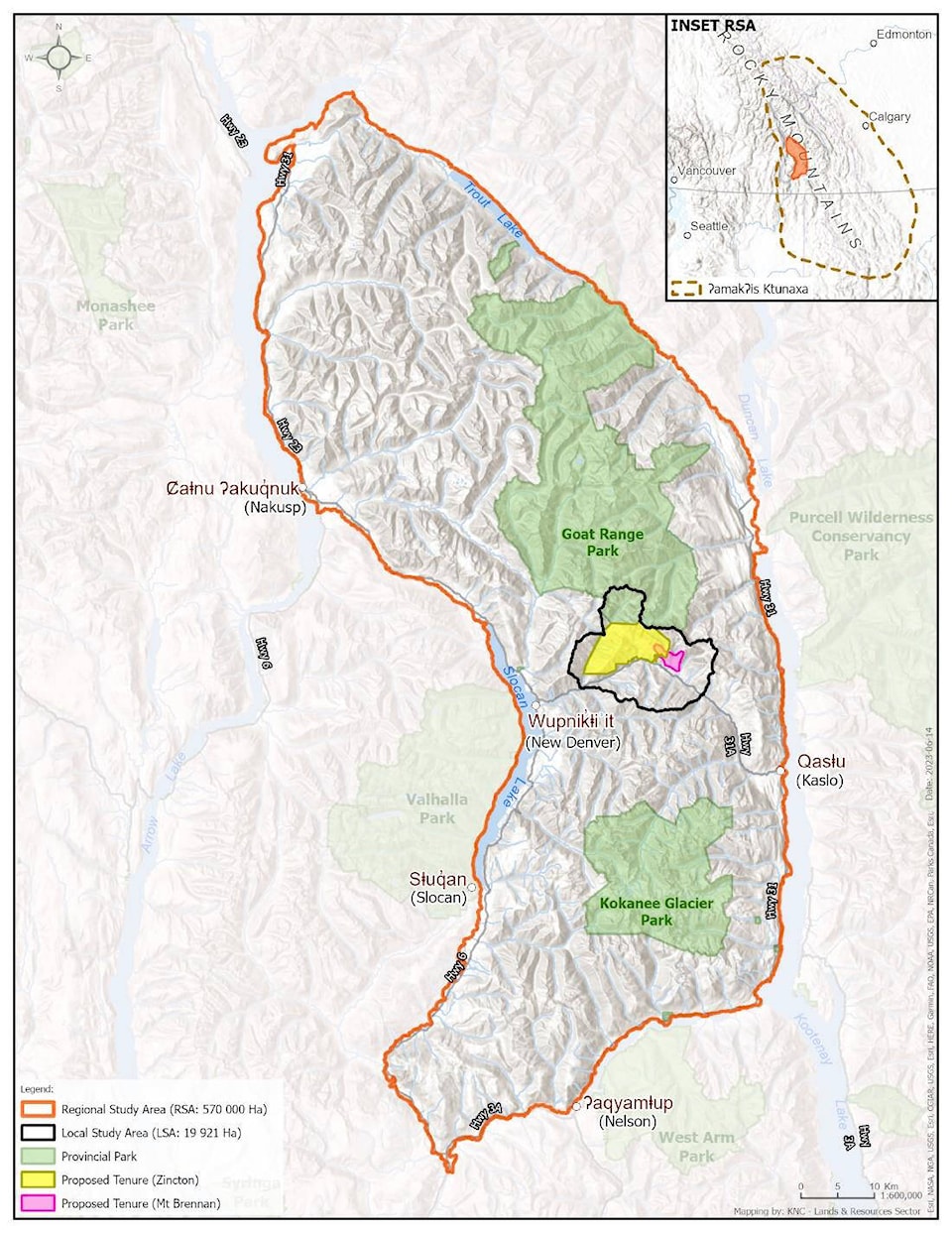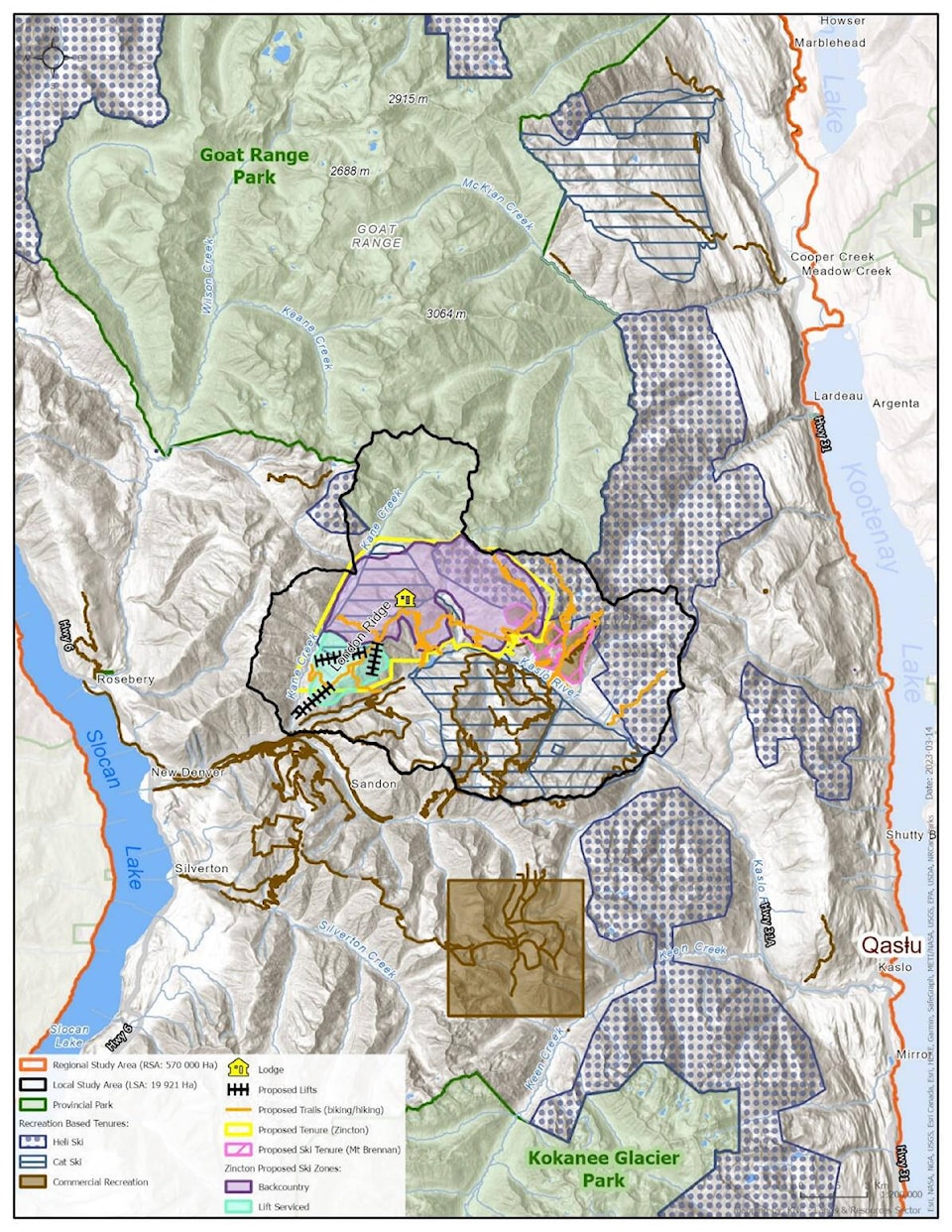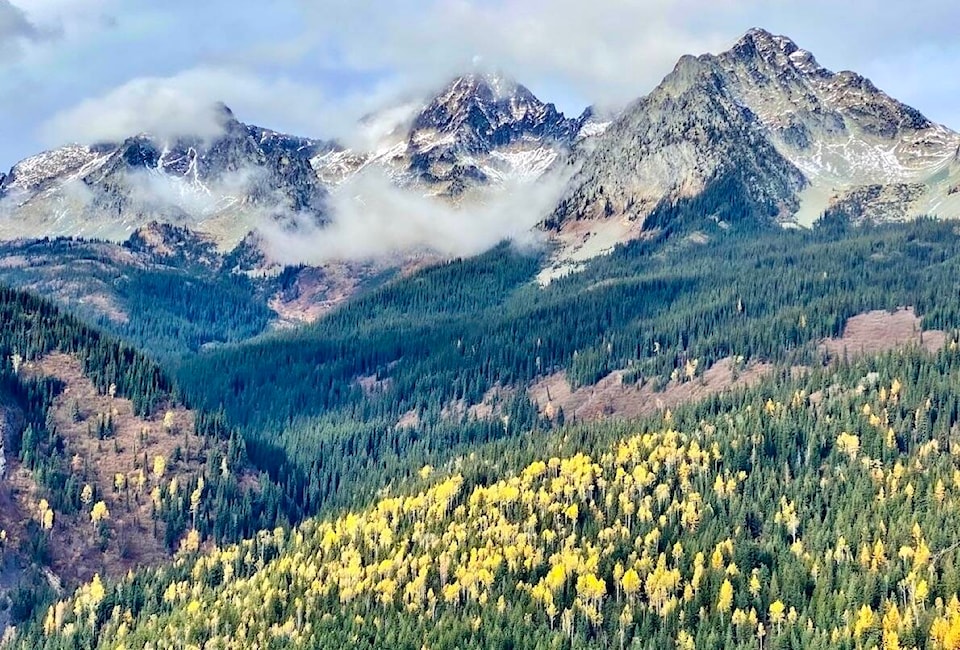The Zincton resort project would be a significant threat to local populations of grizzly bear and wolverine, a new assessment report concludes.
It would fragment the quality and quantity of their habitat, as well as that of other wildlife species, according to a study authored by the Ktunaxa Nation Council.
“Results of this assessment find the cumulative effects of existing and proposed land-use activities within this narrow and vital corridor are considered high hazard,” the report states.
The assessment covers a part of the Selkirk Mountains that is claimed as home territory by both the Ktunaxa Nation Council and the Sinixt Confederacy.
The 70-page assessment report, entitled A Ktunaxa Cumulative Effects Evaluation for a Portion of ʔamakʔis ʔaȼ̓ pu (North Slocan), selected the wolverine and the grizzly bear as “the key benchmark species. They are key species due to their cultural importance, specialized habitat requirements and known sensitivity to recreational activities.”
A summary and the full report can be found at https://tinyurl.com/2ef8ywch.

The report also assesses the impacts on moose, mountain goat, western toad, huckleberries, old growth forest and fish habitat, concluding that land-use planning should not be restricted to the impacts of Zincton but should be regional.
“Only such a comprehensive approach will ensure the cultural and environmental values and rights of Ktunaxanin̓tik (the Ktunasa people) are respected and honoured into the future.”
The report states that its 12 authors and contributors include “subject-matter experts (Ktunaxa and non-Ktunaxa), Ktunaxa citizens, and western science biologists.”
The Zincton proposal would see a wilderness resort built on 5,000 hectares in the Selkirk Range, on both private and public land, in the backcountry between New Denver and Kaslo, and in the vicinity of four parks: Kokanee Glacier, Goat Range, Valhalla and the Purcell Wilderness Conservancy. The project is now enmeshed in the provincial government’s many stages of application and approval for wilderness tenures.
In addition to Zincton, the assessment report addresses a non-mechanized adventure tourism proposal known as Mount Brennan Backwoods Recreation, located adjacent to and east of Zincton. Like Zincton, that project has applied for provincial government approval with no decision yet.
The Ktunaxa assessment looks at the cumulative impacts of recreational and all other human activity in the study area, including forest harvest, wildfires, insect infestations, foreseeable urban and rural expansion, increased traffic volume, recreational activities and climate change.
The authors used ALCES, a software designed to simulate past and future cumulative environmental effects. The analysis focuses not only the likelihood of habitat loss but of habitat fragmentation and degradation.

The assessment states that its authors have attempted to answer the question, “How much recreational activity, (coupled with existing land uses such as mining, forestry, roads, other linear corridors, urban/rural development, etc.) exceeds the carrying capacity of the land and the associated tolerance limits of biodiversity components?”
The authors acknowledge that the owners of the Zincton project have planned a wildlife corridor protection zone with opportunities for grizzly bear viewing, but they question whether restrictions on public access would be enforced or enforceable.
The assessment report states that the impacts of such recreation tenures are often larger than the designated area because “recreational users often spread out and cover vast areas and do not confine their activities to existing trails and/or designated use areas,” and this can affect the denning of wolverines and grizzlies.
Other findings
• An estimated 20 per cent reduction in summer habitat quantity and quality for grizzly bears has occurred since pre-contact, and another 48.8 per cent reduction is predicted with approval of the developments.
• Ninety-four per cent of the huckleberry crop will be threatened, with implications for bears and for cultural harvest.
• Wolverine habitat could be reduced by 21 per cent to 60 per cent.
• There would be significant reductions in quality and quantity of mountain goat and moose habitat.
• Decreasing snow levels and increasing air and water temperature due to climate change may exacerbate all of the above effects in ways that are difficult to predict.
Ktunaxa and Sinixt
The report states that the Ktunaxa actively use the study area, and that the projects may compromise their ability to do this.
“We maintain stewardship responsibility for the area that incorporates our laws and values, including respecting and nurturing ʔa·kxam̓ is q̓api qapsin (all living things). We actively use the study area for the exercise of Ktunaxa rights, including knowledge transmission and harvesting resources (huckleberry).”
In February, the Sinixt Confederacy of the Colville Confederated Tribes, called for the provincial government to conduct a formal environmental assessment of the Zincton proposal. Such an assessment is an option in the government’s approval process, but the province says it does not know whether it will order one.
The Sinixt’s letter explained that the Supreme Court of Canada, in its 2021 decision in R. v. Desautel, declared the Sinixt an aboriginal people of Canada. That gives the Sinixt “a constitutionally protected right to hunt in their traditional territory in British Columbia, and to be engaged and consulted on anything that would impact those rights.”
The Sinixt Confederacy and the Ktunaxa Nation both claim the territory in which the Zincton proposal resides. Neither group responded to the Nelson Star’s request for comment for this story.
The provincial government process
No one at the Ministry of Tourism Arts, Culture and Sport (TACS), which is overseeing the tenure application process for both projects, was willing to be interviewed about the Ktunaxa assessment report.
However, an email from a ministry communications spokesperson stated, “the report provides valuable information regarding cumulative effects, environmental values and Ktunaxa’s interests within the area, which are being considered within its major project review of the resort proposal by TACS.
“TACS staff will continue work with agency partners, local government, stakeholders and area First Nations including the Ktunaxa and Sinixt First Nations as part of the review process including a fulsome environmental assessment.”
David Harley, the lead proponent of the Zincton project, responded to the Ktunaxa report in an email to the Nelson Star, stating, “Zincton was pleased to see the Ktunaxa CEA paper. We look forward to studying it more as time permits.”
He said Zincton wants to improve the environment, not damage it.
The plan includes remediating the Whitewater Canyon lead and zinc mining contamination that has been flowing into the Kaslo River and into Kootenay Lake for more than a century, he said.
Harley also downplayed the perception that Zincton will intrude on the natural world.
“Zincton’s mission is to be inclusive, small-scale and climate-neutral — rustic/backcountry/van life, not a slick downhill ski resort.”
READ MORE:
• Sinixt Confederacy asks B.C. for formal assessment of proposed Zincton resort
• Public consultation process set to close for proposed recreational area near New Denver
• Sinixt Confederacy opens office in Nelson
• Petition against Zincton backcountry proposal picks up
• Online survey shows range of support for Zincton ski development
